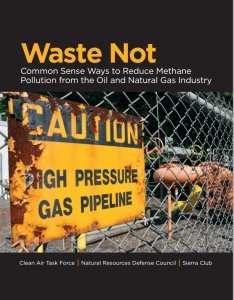Full Title: Waste Not: Common Sense Ways to Reduce Methane Pollution from the Oil and Natural Gas Industry
Author(s): David McCabe, Ph.D.,Meleah Geertsma, Nathan Matthews, Lesley Fleischman, and Darin Schroeder
Publisher(s): Clean Air Task Force, Natural Resources Defense Council, and the Sierra Club
Publication Date: January 1, 2015
Full Text: Download Resource
Description (excerpt):
The case for taking action on climate change has never been clearer: as the third National Climate Assessment states, the U.S. is already experiencing the effects of climate change, from increasing heat across the country to more extreme weather events totaling billions of dollars in damage. Given these impacts, and much worse to come, the cost of inaction to our health, environment, and economy is far too great, especially when effective and lowcost means for reducing climate-warming pollution are available now. In this report, we show how the U.S. Environmental Protection Agency (EPA) can fulfill the agency’s duty under the Clean Air Act to cut by half dangerous, wasteful methane pollution from the largest industrial source—the oil and gas industry—in just a few years, using common sense standards based on available, low-cost control measures for a targeted set of pollution sources. Reducing methane emissions from the oil and gas sector would build on the Obama Administration’s actions to date to cut climate pollution. Most recently, in a landmark U.S.-China agreement, the President announced a U.S. target of reducing greenhouse gas emissions 26 to 28 percent below 2005 levels by 2025. This pledge follows on the previous U.S. commitment to reduce emissions by 17 percent below 2005 levels by 2020. In June of 2014, EPA took its most significant climate protection step to date by proposing the Clean Power Plan to tackle the predominant climate pollutant, carbon dioxide (CO2), from its largest U.S. source, existing power plants. The Administration has also set standards in motion to reduce carbon pollution and improve fuel efficiency from new motor vehicles, addressing the second-largest U.S. source of CO2.
